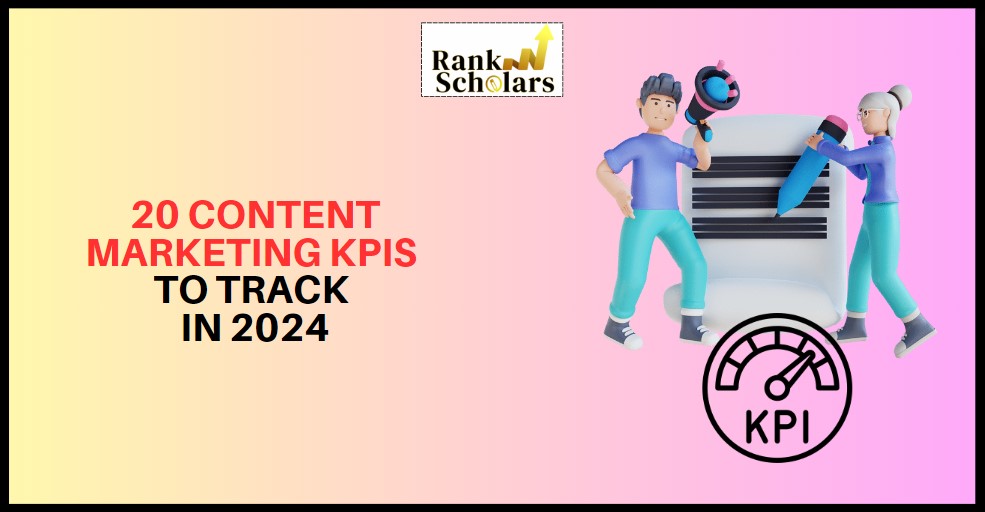One of my friends recently started putting in content marketing efforts to establish her digital presence online. But she was not aware if she was getting any results or not. She was worried about the efficiency and efficacy of her content marketing.
Are you too worried about the efficiency of your content marketing efforts? Do you want to know if your content marketing efforts are producing good results? To get the answers to these questions, you need to track metrics.
To track metrics, you should know which ones to track. We are here for you with various content marketing KPIs to track. This article will cover what are KPIs, what is the importance of monitoring content marketing KPIs, things to consider before choosing KPIs, and various types of KPIs and how they align with your business goals.
What Is A KPI In A Content Strategy?
KPI in a content strategy means Key Performance Indicator. These are trackable and measurable metrics that help you determine the effectiveness, efficiency, and success of your content strategy and efforts.
Various KPIs provide different insights into how well your content is performing in accordance with your business goals like brand awareness, website traffic, and engagement rates. These also help you identify areas for improvement and guide future content strategies and efforts.
What’s The Importance Of Tracking KPIs?
Tracking of Key Performance Indicators is essential in any industry or marketing strategy, more so in your content marketing goals, as it provides measurable insights into the efficiency of your marketing efforts and helps you in making data-driven decisions.
Following are some of the key reasons why it is important to track KPIs.
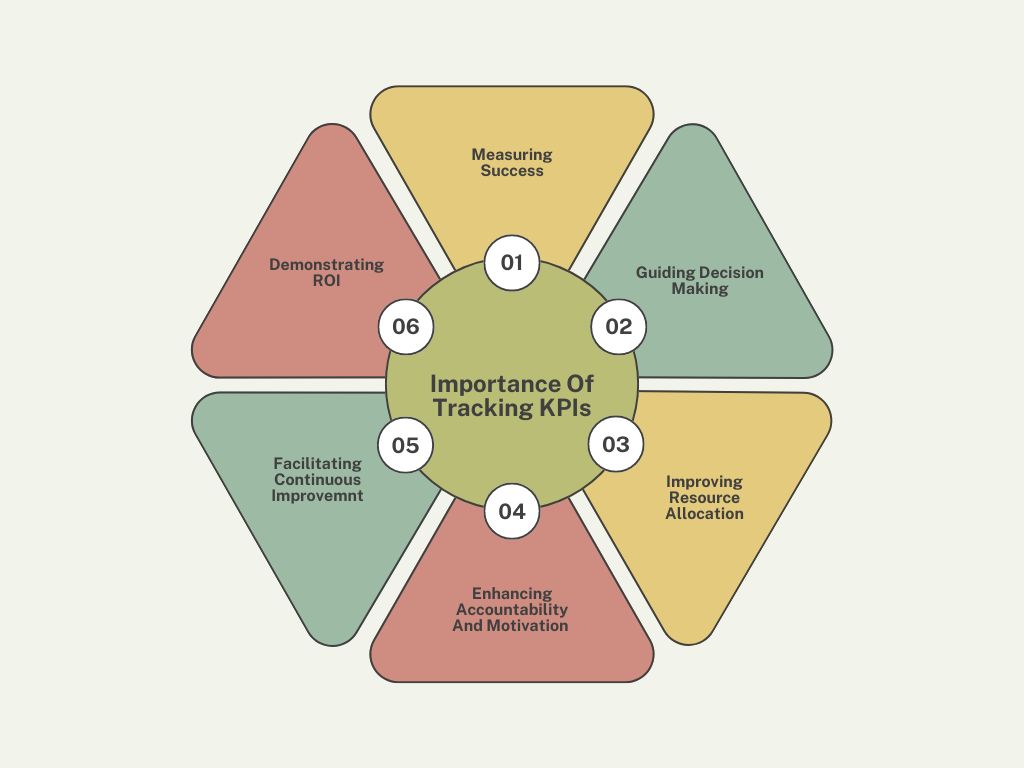
Measuring Success
KPIs act as a quantifiable measure of the success of your content strategies and efforts. This helps businesses determine if their strategic objectives are being achieved. They can get to know if their content strategy is on the right track or if there’s something that needs to be improved immediately. KPIs ensure that your content efforts are perfectly aligned with your organizational goals such as website traffic, consumer engagement, or boosting sales.
Guiding Decision Making
Decision-making based on data insights is critical for optimizing your content strategy. You can identify the trends, strengths, weaknesses, and areas of improvement in your content strategy.
You can figure out what types of content are working for you and what are not. With the help of this information, you can allocate your resources more efficiently and create more effective strategies. This way you can maximize your ROI.
Improving Resource Allocation
Tracking content marketing KPIs will allow you to determine which strategies and pieces of content yield the best results for you. You can prioritize your efforts on a similar type of content and better your return on investments.
With the help of these data-driven insights, you can allocate your budget and resources accordingly. This will also in turn prevent wastage of resources and ensure that your content marketing efforts are proving to be cost-effective while producing results.
Enhancing Accountability And Motivation
KPIs are a way of setting benchmarks for your success. By setting clear benchmarks, you can be held accountable. Teams and individuals are proven to be more motivated when they have specific goals to work for and can see their efforts getting results with KPIs.
This encourages a culture of performance and result-driven efforts which in turn boosts productivity and morale of the people working. When people know what to work for, they align their efforts with the company’s goals and requirements.
Facilitating Continuous Improvement
The process of tracking content marketing KPIs provides room for continuous scope of improvement via data-driven information. By keeping a check on performance data, you can identify the gap areas and make changes in your strategies based on information.
This process of reviewing KPIs every once in a while helps keep strategies fresh and evolving in the market. It also helps in encouraging innovation and creativity as it motivates teams to experiment with new ideas based on data.
Demonstrating ROI
Tracking content marketing KPIs is significant to demonstrate the returns on investment in your content marketing efforts. Businesses can determine the benefits of their strategy by connecting specific KPIs in terms of financial outcomes.
This explains all current expenditures and supports your future content marketing goals and initiatives. Presenting ROI in terms of KPIs builds trust and credibility among the partners and helps in your future endeavors.
4 Things To Consider Before Choosing Your Content Marketing KPIs
Selecting the right KPIs is essential for measuring the success of your content marketing efforts and driving business growth. But what are the key considerations to keep in mind before choosing your content marketing KPIs? Let’s find out!
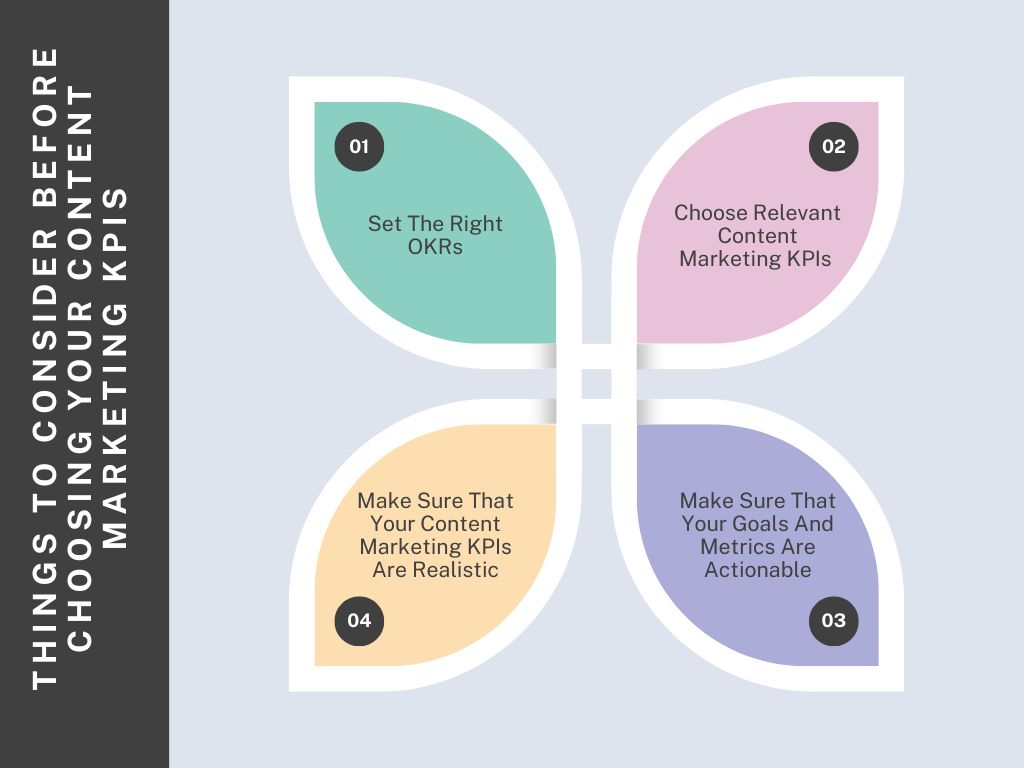
1. Set The Right OKRs
Before choosing your KPIs, it is important to set clear Objectives and Key Results. OKRs will help you determine the goals that you want to achieve and will allow you to create an outline of how to achieve your goals.
When you set the right OKRs, you ensure that your content efforts align with the overall objective of your business and have a clear pathway to follow. This allows you to contribute directly to the outcomes and has a proper framework for tracking metrics.
2. Make Sure That Your Content Marketing KPIs Are Relevant
The KPIs you select should be directly related to your business goals and objectives. These should provide insights into how well your content strategy is doing and is the progress aligned with the goals of your company.
By ensuring that your KPIs are relevant, you can focus on metrics and results that matter and drive relevant improvement from them. For instance, if your company’s goal is to establish its brand presence, then you need to focus on interactions, traffic, and social media engagement.
3. Make Sure That Your Content Marketing KPIs Are Realistic
Setting unrealistic benchmarks for judging and examining your KPIs would lead to frustration and demotivation among the employees. It is essential to set KPIs that can be achieved within the said time frame and the resources allocated.
You should analyze market trends, your capabilities, and available resources to determine achievable targets. Realistic KPIs will maintain motivation and keep the momentum going in your team while ensuring that the goals are achieved.
4. Make Sure That Your Goals And Metrics Are Actionable
Your selected KPIs should ultimately lead to giving you actionable insights on your content performance that you can implement and make improvements. Actionable KPIs provide you with a clear picture of what improvements are needed and how to achieve them.
While selecting KPIs, make sure to consider how the results will guide you and influence your content marketing approach. For instance, if a KPI results in low engagement rates, then, the content relevance should be reviewed to increase targeted audience interaction.
Choosing The Right Content Marketing KPIs
Choosing the right content marketing KPIs is essential to determine if your content marketing efforts are working or not. With the help of content marketing KPIs, you can get quantifiable metrics and determine if your content marketing efforts align with your business goals.
Let’s look at various types of key performance indicators that you can track to improve your content marketing strategy.
1. Content Marketing KPIs To Use For Increasing Brand Awareness
Increasing brand awareness through content marketing requires a high reach and engagement of your content on search engines. For this, you need to track some specific key performance indicators that determine your reach and engagement.
Following are some of the KPIs that you should track to increase brand awareness.
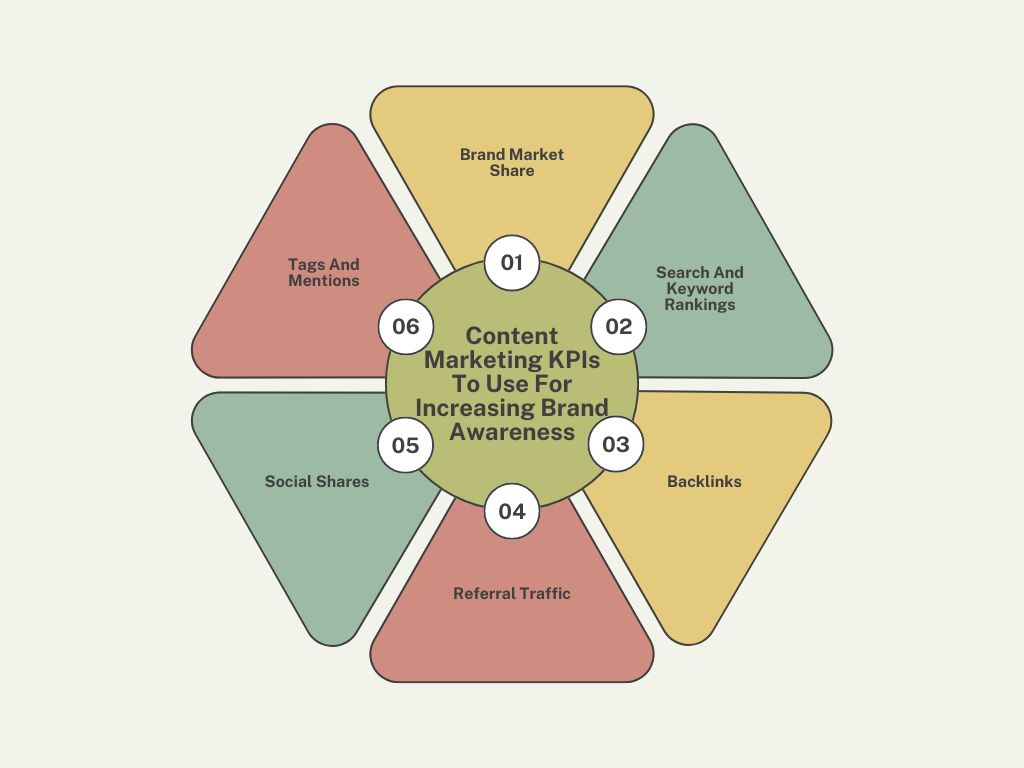
2. Search And Keyword Rankings
Search and keyword rankings measure how well your content ranks in search engine ranking pages in results for specific keywords. Higher rankings in search engine results pages ensure more chances of being discovered by new audiences and better engagement rates.
By optimizing your content according to search engine algorithms and targeted keywords, you can improve your rankings on SERPs, boost your engagement, and increase your brand awareness, and its authority and credibility among new audiences.
3. Backlinks
Backlinks are links on other websites that lead the targeted audience to content on your website. These are links on external websites that pose as a key indicator of the authority and credibility of your content.
Earning high-quality backlinks from external websites that are not paid or forged, increases the visibility of your content on search engines, enhances your trustworthiness, drives referral traffic, and betters your brand awareness.
4. Referral Traffic
Referral traffic refers to the audience that lands on your content via links from other websites, that is backlinks, excluding search engines. The quality and quantity of your backlines help you gain traction on search engines and generate more traffic.
Gaining referral traffic with the help of strategic partnerships, guest post articles, and barter collaborations helps your brand attract new audiences and build brand awareness beyond your basic and immediate network.
5. Social Shares
Social shares are referred to as the number of times your content has been shared across various social media platforms. This number reflects the popularity and engagement of your posts which also increases your reach.
Encouraging social shares increases your brand’s awareness among a new audience of social media, expands your brand’s reach, and helps attract new and loyal followers who are influenced by your social media content.
6. Tags And Mentions
The number of times your brand is referenced, tagged, or mentioned in social media posts, articles or other content is when tags or mentions are counted. Tags and mentions are essential to get to know about your brand’s perception in social media.
Keeping track of your tags and mentions and regularly monitoring them helps you gauge public perception and talks surrounding your brand. Having positive tags and mentions will increase your brand’s visibility and reach.
7. Brand Market Share
Brand market share is the percentage of the overall market that is owned by your brand. This is an important metric in industries where there are some selected few companies that own a large market share.
Tracking marketing share helps you determine your brand’s position in the industry. By increasing your market share with the help of strategic marketing initiatives and collaborations, you can improve your brand’s awareness and competitive edge.
Content Marketing KPIs To Use For Generating More Leads
Lead generation is an essential task in any business. With the help of effective content marketing efforts, you can generate more leads and convert potential clients. To effectively generate more leads through content marketing and converting them, you can track some KPIs to focus solely on that.
Following are the KPIs that you should track for lead generation.
1. Click Through Rate
Click-through rate measures your content’s effectiveness in motivating your audience to take action. CTR is calculated by dividing the number of clicks by the number of times the content is viewed and is expressed in percentage.
Higher CTR is an indicator of your content being effective and successfully engaging the audience. CTR is an essential KPI to track how well your content drives potential leads toward the outcome that your company desires.
2. Cost Per Lead
Cost Per Lead evaluates the efficiency of your content marketing efforts in generating leads. It is calculated by dividing the total cost of your content marketing campaigns by the number of leads generated.
This metric helps in determining the cost-effectiveness of your content marketing strategy and how much you are spending to acquire each new lead. With the results from this metric, you can optimize your strategy and better the ROI by making it more cost-effective.
Content Marketing KPIs For Increasing Conversions
Generating leads is only the first step and does not guarantee you any business from the lead. To get business from the lead, you need them to convert them into your clients. To effectively convert more leads from content marketing, you need to track the KPIs that reflect the results of your desired goals.
Here are some KPIs that can be used to increase conversions through content marketing.
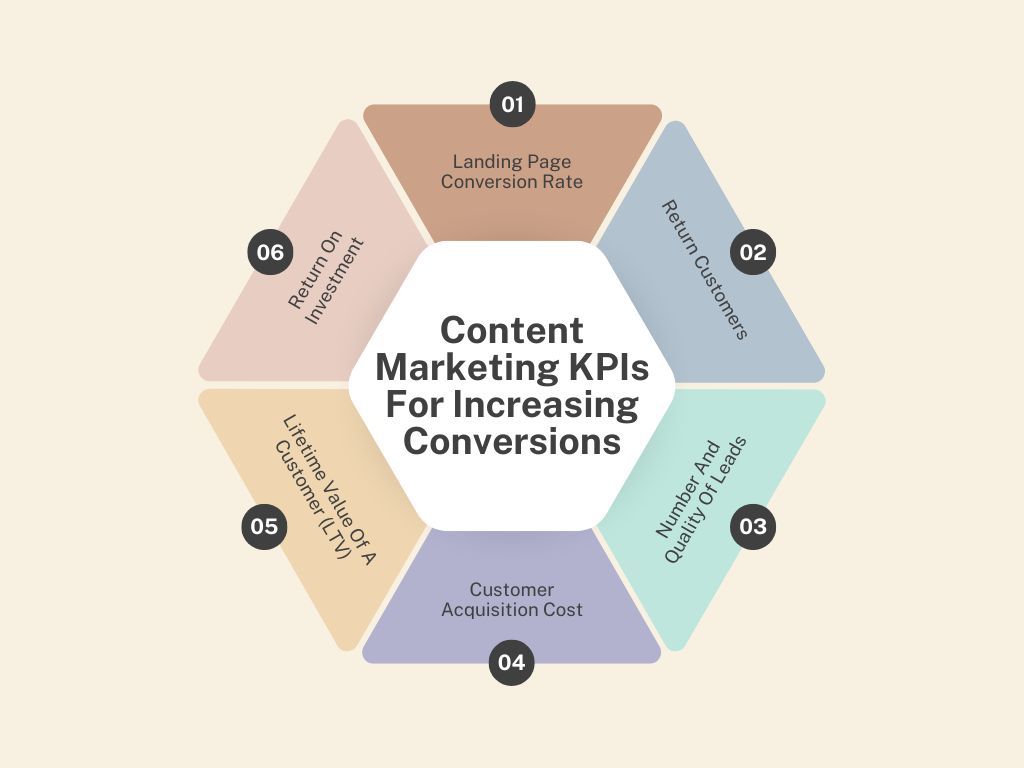
1. Landing Page Conversion Rate
Landing page conversion rate measures the percentage of visitors on your landing page who complete a desired action, after landing on your page. The action can be anything that your company desires, such as signing up for a newsletter or making a purchase.
High conversion rates indicate that your page influences the audience effectively and manages to convince them to take the desired action. Optimizing this KPI will include improving design, content, and CTAs to motivate the audience to act.
2. Return Customers
Return customers are the customers who make repeat purchases from your business. This KPI tracks the repeat rate of your customers and helps you determine how many customers get back to your business for more, indicating satisfaction from your brand.
A high rate of return customers shows that the customers are loyal to your brand and that your content strategy is effective and keeps your audience engaged which encourages better and long-term relationships with your customers.
3. Number And Quality Of Leads
The number and quality of leads let you know both the quality and quantity of the leads that you are generating. This KPI determines the quality of potential customers that you have generated through content marketing efforts.
High-quality leads are more likely to convert into paying customers. By evaluating this KPI, you can optimize your content strategy and content marketing efforts and have a targeted focus on valuable and potential leads that are more likely to convert.
4. Customer Acquisition Cost
Customer acquisition cost is the total amount that is spent to acquire a new customer. CAC also includes all the marketing and sales costs to ascertain the real amount that is spent.
Lowering CAC while increasing lead conversion is the main goal that makes sure that your marketing efforts are cost-effective and sustainable. Determining this KPI will help you in knowing the efficiency of your content marketing strategy in converting leads to customers.
5. Lifetime Value Of A Customer (LTV)
The lifetime value of a customer is the total revenue a business expects from a single customer throughout its relationship. This KPI helps assess the long-term impact, customer retention, and profitability.
This metric considers the customer’s revenue value and compares it with the company’s predicted value. Increasing LTV will include creating content that keeps your customers engaged, encourages customer loyalty, and increases the chances of repeat business.
6. Return On Investment
Revenue on investment determines the profitability of your content marketing strategies by comparing the revenues generated to the expenses put into executing those strategies. This KPI ultimately indicates how effective your content strategies are.
A positive return on investment means that your content marketing efforts are generating sufficient revenues to justify your expenses of the same. Increasing this metric would involve optimizing content that generates the maximum possible impact.
Content Marketing KPIs For Boosting Engagement
High engagement in your content means that the audience interacts with your content and finds it relevant and useful enough to go through it. To achieve the goal of boosting engagement with the help of your content marketing efforts, you can track some important
KPIs that indicate how well your audience is interacting with your content.
Following are some of the important KPIs that you can track to boost engagement through content marketing.

1. Organic Traffic/Page Views
Organic traffic/page views refers to the number of visits that your website has gained through unpaid search engine results. It is a significant indicator that determines how well your content is doing in terms of Search Engine Optimisation (SEO).
To assess the visibility and reach of your content, it is important to know about the organic traffic and pageviews of your website. High organic traffic means that your content is optimized for search engines while high page views indicate that your content is engaging enough to retain audiences.
2. Click-Through-Rate
Click-through rate (CTR) is the percentage of users who click on a link or call to action (CTA) after seeing it. CTR is generally used to evaluate the efficiency of your headlines, meta descriptions, email newsletters, and social media engagement.
A high CTR indicates that your content is compelling enough to get the audience to the end of it and is influential enough to prompt them to take action. By optimizing content and improving your CTA, you can drive more conversions and retain an audience too.
3. Time On Page
Time on page is a metric that refers to the average amount of time a visitor spends on a specific page of your website. This KPI helps you determine how engaging and relevant your content is to your audience.
Longer time on your page indicates that your audience finds your content relevant and valuable which leads to higher engagement and lower bounce rates. By analyzing this KPI, you can determine which content resonates with your audience and make efforts in the same direction.
4. Pages Per Session
Pages per session tracks the average number of pages that a visitor views during a single session on your website. It is a significant KPI that measures user engagement and site navigation.
A higher number of pages per session indicates that the audience is exploring more of your content and finding your content engaging. With proper optimization of your website’s content and structure, you can encourage your visitors to explore more content on your website.
5. Bounce Rate
Bounce rate is the number of viewers who bounce off your website after viewing only one page. This content assesses your content’s effectiveness and user experience. A high bounce rate is an indicator that your website does not meet the expectations of the visitors.
Analysis of bounce rate will let you know about areas for improvement on your website which can better your user experience. Reducing the bounce rate will lead to more user engagement as users are more likely to visit your site and explore your content.
6. Comments
Comments are a direct indicator of interactions on your content, whether on your blog posts or your social media content. These comments show how your content resonates with the audience and provide you room for improvement with their feedback.
Active engagement and interaction with comments will let you build stronger relationships with your audience and foster a sense of loyalty and community among them. Comments will let you know about their preferences and interests based on which you can tailor your future content.
Final Words
Using the above-listed key performance indicators can help you make data-driven decisions and enhance your content marketing efforts while driving better results. With proper KPI tracking, you can also optimize your website and pages as per consumer expectations and hence generate more leads that convert. If you need help with improving your organic presence & generating more leads, contact us TODAY!

Anubhuti is a freelance writer who crafts engaging content. Running on a single cup of coffee, on most days, she prefers books and music over people and loves creating compelling content for you!

